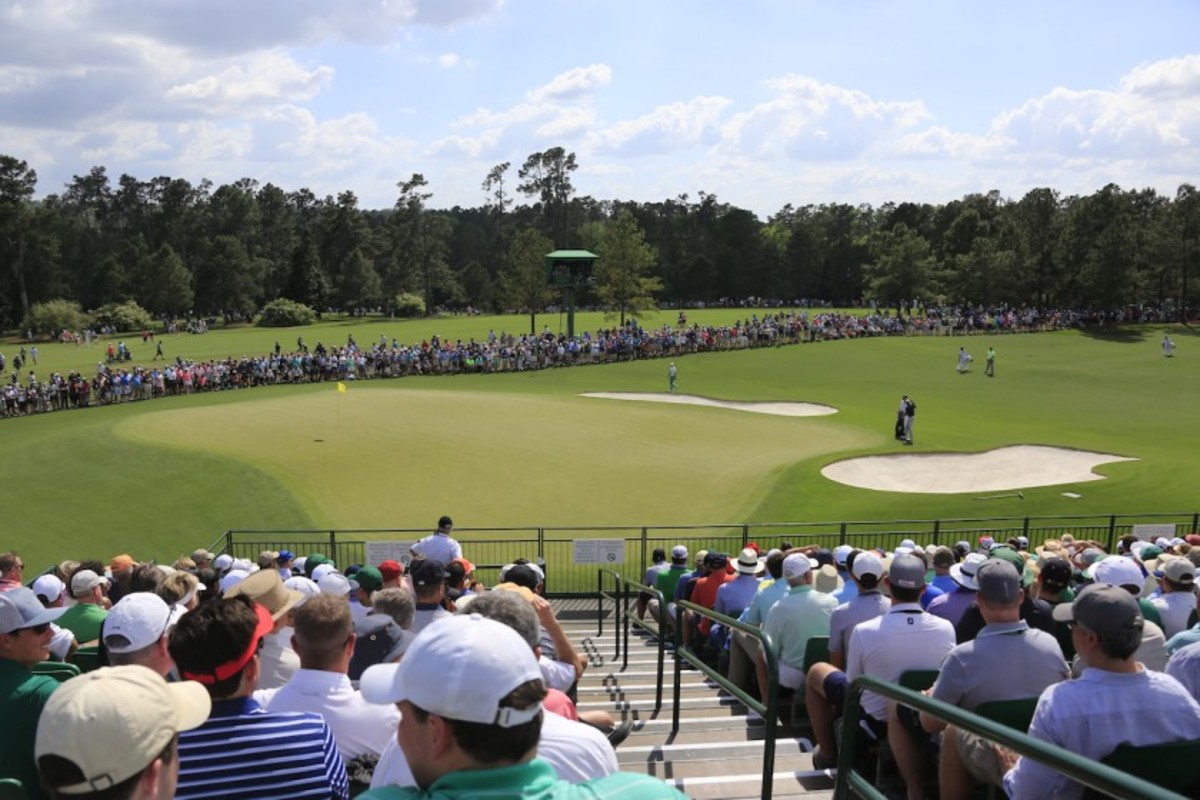Masters 17th Hole: Stats, History, Memorable Moments From Augusta National’s Par-4 ‘Nandina’

A closer look at Augusta National Golf Club's 17th hole for the Masters:
Name: Nandina
Par: 4
2021 yardage: 440
1934 yardage: 400
2021 scoring average: 4.19
All-time scoring average: 4.16
All-time difficulty rank: 9
Lowest year: 3.94 (1996)
Highest year: 4.34 (1951)
THE LAYOUT
This hole works its way uphill. A drive near the fairway’s crest brings into view the green that has bunkers located front center and left. The best plan of attack into the green is from the right side of the fairway. There is an opening to the green of about 10 yards between the two bunkers, so most approaches will need to carry one of the bunkers. The green features undulations in all directions, so getting an approach close or two-putting would be an admirable feat.
SIGNIFICANT CHANGES
1951: Ditch in front of tees removed and filled. Masters tees extended forward 10 yards.
1972: Tees separated, moving Masters tees back 10 yards.
1999: Masters tees moved back approximately 25 yards.
2006: Masters tees moved back 10-15 yards.
2014: Eisenhower Tree removed following historic ice storm.
Notes: The hole originally was designed without the large bunkers guarding the green’s front. … Until 1999, the Eisenhower Tree on the fairway’s left side did not hinder competitors. The loblolly pine became more of a factor when the Masters tees were moved back 25 yards and slightly to the left that year. By the time the tees were moved back again in 2006, the tree that grew to a height of about 65 feet was located about 210 yards from the Masters tee and was becoming difficult to hit over. The ice storm that prompted the tree’s removal damaged more of the pine’s major branches.

ODDS AND ENDS
For the longest time, a tree intruding on the fairway’s left side was of little consequence to Masters players. But the tall pine, located about 100 yards in front of the members’ tee, proved to be a nuisance for President Dwight Eisenhower, whose slice often did battle with the tree. Eventually, at a 1956 Augusta National governors meeting, Eisenhower proposed cutting down the tree. Masters co-founder Clifford Roberts ruled Eisenhower out of order and adjourned the meeting. End of story.
In 1958, Arnold Palmer benefitted from the tree, which had become known as Ike’s Tree. In the final round, Palmer, leading by a stroke, attempted to draw his tee shot, but it was more of a snap-hook that hit the tree’s trunk. The ball, however, careened back into the fairway. Palmer made a par and ended up winning his first Masters title.
In 1968, Roberto De Vicenzo shot a spectacular 7-under-par 65 in the final round, which included an eagle on the front nine. At the par-4 17th, De Vicenzo made a birdie, but playing competitor Tommy Aaron, the keeper of De Vicenzo’s score, wrote down 4. De Vicenzo bogeyed the 18th to fall back into a tie with Bob Goalby, and an 18-hole playoff the next day was being scheduled. At the scorer’s table, though, De Vicenzo did not do the proper math on the scorecard that Aaron kept; otherwise, he would have counted up 66 strokes instead of 65. The Rules of Golf state that for a player who turns in a score on a hole higher than he actually made, the written score must stand. As a result of his mistake, De Vicenzo lost by a stroke to Goalby, who often believed that he never got full credit for winning the Masters.
Nineteen times a player has made the hole’s high score of 7, most recently by Fred Couples and Ted Potter Jr. in 2013. There have been three eagles made on the hole, the last being in 1998 by Davis Love III. Gary Hallberg (1983) and John Daly (1996) birdied the 17th in each round of the Masters.
MEMORABLE MOMENTS
1986: By the time Jack Nicklaus, 46, reached the 17th green, there was little doubt on the Augusta National Golf Club grounds that the five-time Masters champion was in contention for a sixth green jacket. Nicklaus began the day tied for ninth, four strokes behind Greg Norman. Despite three straight birdies, a bogey at the par-3 12th hole still left Nicklaus three strokes behind leader Seve Ballesteros. Nicklaus regrouped to birdie the 13th, eagle the 15th and birdie the 16th. At the 17th, Nicklaus, tied with Tom Kite at 8 under par and a shot behind Ballesteros, drove his tee shot into the left gallery, but had a good angle into the back-right hole location. Nicklaus hit his approach from 125 yards to 12 feet left of the hole. As he walked to the green, Ballesteros was finishing a bogey that dropped him into a three-way tie at 8 under. Nicklaus read the birdie putt as breaking from left to right but back left toward Rae’s Creek at the very end, and the ball did exactly that. As the ball dropped into the cup, Nicklaus lunged forward and thrust his putter, then both arms skyward in exaltation. At 9 under, Nicklaus was in sole possession of the lead for the first time all week. CBS commentator Verne Lundquist simply said: “Yes, sir!” Nicklaus signed for a final-round 65 that included a back-nine 30, then watched his contenders. Kite missed a birdie attempt at 18 and finished at 8 under. Norman matched Nicklaus at 9 under with a birdie at 17, but gave the stroke away with a bogey at 18. Nicklaus had become the oldest Masters champion.
SEE MORE OF AUGUSTA NATIONAL'S BACK NINE
10 | 11 | 12 | 13 | 14 | 15 | 16 | 17 | 18
